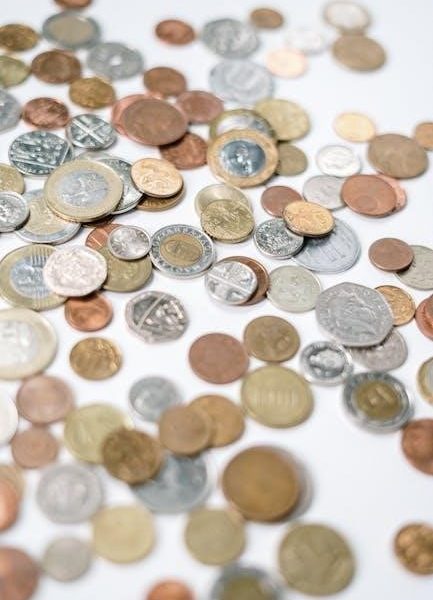
australian coin collection list pdf
Australian coin collection is a fascinating hobby‚ offering insights into history and culture. A PDF list helps organize and manage collections‚ providing detailed information on rare and valuable coins‚ making it an essential tool for enthusiasts.
Overview of Australian Coin Collecting
Australian coin collecting is a popular and rewarding hobby‚ offering insights into the nation’s history and culture. With the help of a PDF collection list‚ enthusiasts can easily organize and manage their coins‚ ensuring they don’t miss rare or valuable issues. Online resources provide comprehensive guides‚ including detailed value charts‚ high-quality images‚ and historical insights. Collectors can identify rare and error coins‚ such as the 1930 Proof Penny or the 1988 Coat of Arms Error‚ and track market trends. Whether focusing on circulating coins‚ commemorative issues‚ or precious metal bullion‚ a well-organized collection list enhances the journey‚ making it both enjoyable and informative.
Importance of a Coin Collection List in PDF Format
Importance of a Coin Collection List in PDF Format
A PDF collection list is indispensable for Australian coin enthusiasts‚ offering a structured approach to organizing and tracking coins. It provides detailed information on coin values‚ mintage details‚ and historical context‚ essential for identifying rare and error coins. With features like filtering by year‚ denomination‚ and metal type‚ collectors can efficiently manage their inventory. The portability and accessibility of PDF guides make them ideal for both beginners and advanced collectors‚ ensuring they stay informed about market trends and coin availability. This tool enhances the collecting experience‚ aiding in making informed decisions and maximizing the collection’s potential.
History of Australian Coins
Australia’s coinage began in 1910 with the Australian pound‚ transitioning to the decimal system in 1966. This shift introduced iconic coins like the 1984 one-dollar piece‚ reflecting cultural evolution.
Evolution of Australian Currency
Australia’s currency has undergone significant transformations‚ from the Australian pound to the decimal system in 1966. This shift modernized the nation’s money‚ introducing dollars and cents. The transition was seamless‚ with the Royal Australian Mint and Perth Mint producing commemorative and bullion coins. These coins now feature iconic designs and cultural themes‚ such as kangaroos and Indigenous art‚ reflecting Australia’s identity. The introduction of decimalization streamlined transactions and aligned the currency with global standards‚ making it more accessible and user-friendly for both locals and international traders. This evolution is well-documented in PDF guides‚ aiding collectors in understanding the historical journey of Australian coins. Additionally‚ these resources provide detailed insights into the development of coin designs‚ metal compositions‚ and the introduction of error coins‚ which have become highly sought after by numismatists.
Key Milestones in Australian Coinage
Australia’s coinage history is marked by significant milestones‚ beginning with the introduction of the Australian pound in 1910. The switch to the decimal system in 1966 revolutionized the currency‚ introducing dollars and cents. Notable milestones include the release of the first decimal coins in 1966‚ such as the iconic 1984 one-dollar coin. The Royal Australian Mint and Perth Mint have since produced commemorative and bullion coins‚ celebrating cultural themes and events. Key milestones also include the issuance of error coins‚ like the 2012 Red Poppy 20 Cent‚ and the integration of Indigenous designs‚ reflecting Australia’s evolving identity. These milestones are well-documented in PDF guides‚ aiding collectors in tracing the nation’s numismatic journey.
From the Australian Pound to the Decimal System
Australia transitioned from the pound to the decimal system in 1966‚ modernizing its currency. The decimal system introduced dollars and cents‚ replacing pounds‚ shillings‚ and pence. This change simplified financial transactions and aligned Australia with global economic standards. The shift was supported by educational campaigns to familiarize the public with new denominations. The introduction of decimal coins in 1966‚ such as the iconic 1984 one-dollar coin‚ marked a new era in Australian numismatics. PDF guides provide detailed records of this transition‚ offering insights into the historical and cultural significance of Australia’s monetary evolution. These resources are invaluable for collectors tracing the nation’s currency transformation.
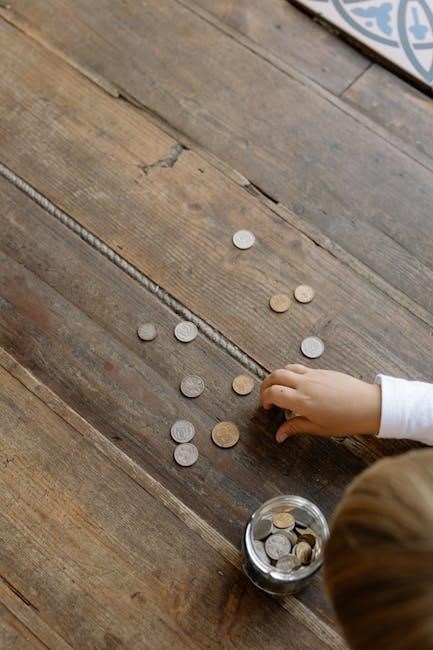
Types of Australian Coins
Australian coins include circulating denominations like cents and dollars‚ collectible issues with unique designs‚ and commemorative themes. PDF guides detail their types‚ metals‚ and cultural significance.
Circulating Coins: Cents‚ Dollars‚ and Commemorative Issues
Australia’s circulating coins include cents‚ dollars‚ and commemorative issues‚ each featuring unique designs. These coins are used daily and are accessible to all collectors. PDF guides list their details‚ helping enthusiasts identify and collect every denomination. Commemorative coins often honor events or cultural themes‚ adding historical value. The guides provide images‚ mintage numbers‚ and values‚ making it easier to build a comprehensive collection. Whether you’re a beginner or an advanced collector‚ these resources ensure accurate identification and valuation of circulating coins‚ enhancing your understanding of Australian numismatics.
Collectible Coins: Unique Designs and Precious Metals
Collectible Australian coins are prized for their unique designs and precious metal compositions‚ such as silver‚ gold‚ and platinum. These coins often feature cultural themes‚ iconic wildlife‚ and historical events‚ making them highly sought after by enthusiasts. PDF guides provide detailed lists of these coins‚ including mintage numbers‚ metal purity‚ and historical context. They highlight limited-edition releases and special commemorative issues‚ aiding collectors in identifying rare and valuable pieces. With high-quality images and descriptions‚ these guides help collectors assess and appreciate the artistic and monetary value of their collectible coins‚ enhancing their numismatic journey.
Commemorative and Bullion Coins
Commemorative and bullion coins are highly sought after for their unique designs and intrinsic value. Commemorative coins celebrate events‚ cultural themes‚ or historical milestones‚ often featuring iconic imagery like kangaroos or Aboriginal art. Bullion coins‚ such as the Australian Kangaroo series‚ are minted from precious metals like gold‚ silver‚ or platinum‚ appealing to investors and collectors alike. PDF guides provide detailed lists of these coins‚ including mintage numbers‚ metal purity‚ and historical context. They highlight limited-edition releases and special commemorative issues‚ aiding collectors in identifying rare and valuable pieces. These coins often combine artistic beauty with investment potential‚ making them a cornerstone of Australian numismatics.
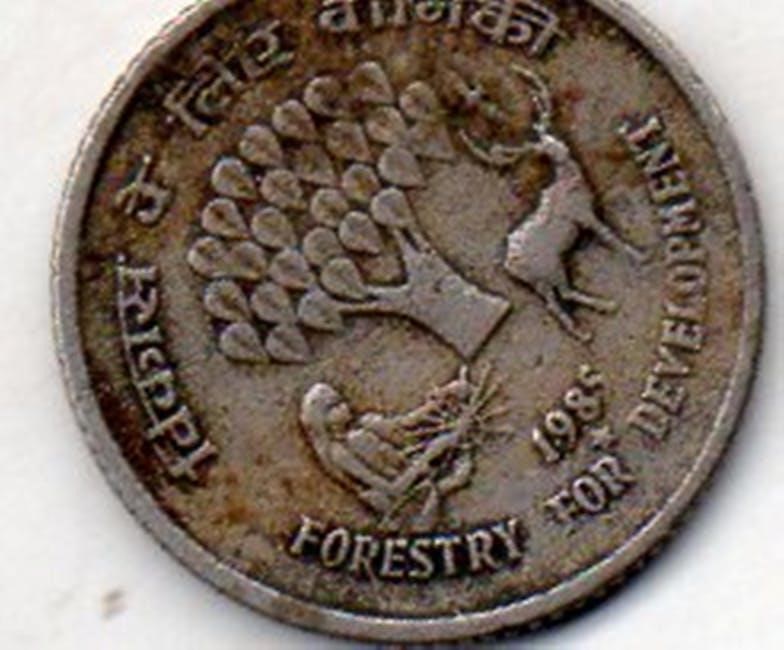
Rare and Valuable Australian Coins
The 1930 Proof Penny is a crown jewel‚ while the 1988 Fifty Cents Coat of Arms Error and 1927 Proof Canberra Florin are highly sought after for their rarity and historical significance.
The 1930 Proof Penny: A Crown Jewel of Australian Numismatics
The 1930 Proof Penny is one of Australia’s most iconic and valuable coins‚ with only a few examples known to exist. Valued at over $1 million‚ it is a true numismatic treasure. This rare coin was part of a proof set produced for the Commonwealth of Australia‚ featuring a kangaroo and the Commonwealth coat of arms. Its extreme rarity and historical significance make it a highly sought-after piece among collectors. A PDF collection list can help enthusiasts identify and authenticate this coin‚ highlighting its importance in Australian numismatic history.
The 1988 Fifty Cents Coat of Arms Error
The 1988 Fifty Cents Coat of Arms Error is a highly sought-after Australian coin due to its unique misprint. This error occurred when the die misaligned during production‚ resulting in a double-struck design on the reverse. The coin features the Commonwealth Coat of Arms‚ but the misalignment creates a rare and distinctive appearance. With only a limited number of these coins in circulation‚ it is considered a crown jewel among Australian error coins. Collectors highly value this piece for its historical significance and rarity‚ often seeking it out using detailed PDF collection lists and guides to identify and authenticate the error.
Other Notable Rare Coins: The 1927 Proof Canberra Florin
The 1927 Proof Canberra Florin is a rare and highly valuable Australian coin‚ symbolizing the nation’s historical transition. It commemorates the opening of the provisional Parliament House in Canberra. Featuring a unique design with the Coat of Arms and parliamentary building‚ this coin is a prized item among collectors. Its rarity stems from limited production and exceptional condition requirements. Collectors often reference detailed PDF checklists to identify and authenticate this coin‚ ensuring its place as a significant piece in Australian numismatic history. Its value is enhanced by its historical and cultural importance‚ making it a standout in any collection.
Error Coins in Australian Collections
Error coins‚ like the 2012 Red Poppy 20 Cent‚ are rare and highly sought after due to unique mis-strikes or double-struck designs‚ enhancing their collectible value.
The 2012 Red Poppy 20 Cent: A Rare Error Coin
The 2012 Red Poppy 20 Cent coin is a notable error coin due to its unique double-struck design‚ making it highly rare and valuable among collectors. This coin‚ part of a commemorative series honoring historical events‚ features a distinct mis-strike that sets it apart from standard issues. Its limited circulation and unique flaw have significantly increased its desirability‚ with collectors eager to add it to their collections. The Red Poppy coin is a prime example of how production errors can elevate a coin’s status in numismatic circles‚ making it a treasured find for enthusiasts and investors alike.
The 1981 20 Cent Error: Unique Mis-strikes
The 1981 20 Cent Error is a highly sought-after coin due to its unique mis-strike‚ resulting from a die alignment issue during production. This error caused the coin to be struck twice‚ creating a distinct double image. Such mis-strikes are rare and add significant value to the coin. With limited circulation and a unique flaw‚ the 1981 20 Cent Error is a prized find for collectors and investors. Its rarity and historical significance make it a standout piece in Australian numismatic history‚ often commanding high prices at auctions and among enthusiasts. Collectors should verify its authenticity through professional grading services to ensure its value and legitimacy.
Understanding Coin Errors and Their Value
Coin errors‚ such as mis-strikes or double-struck designs‚ occur during production and can significantly enhance a coin’s value. These unique flaws‚ like off-center prints or misaligned dies‚ make each error coin distinct. Rarity and condition are key factors in determining value‚ with well-preserved errors commanding higher prices. Collectors and investors seek these coins for their historical significance and uniqueness. Professional grading services‚ such as PCGS or NGC‚ authenticate and evaluate error coins‚ ensuring their legitimacy. A comprehensive PDF guide can help identify and assess these rare finds‚ making them a valuable addition to any collection. Error coins are treasured for their rarity and the stories they tell about minting processes.
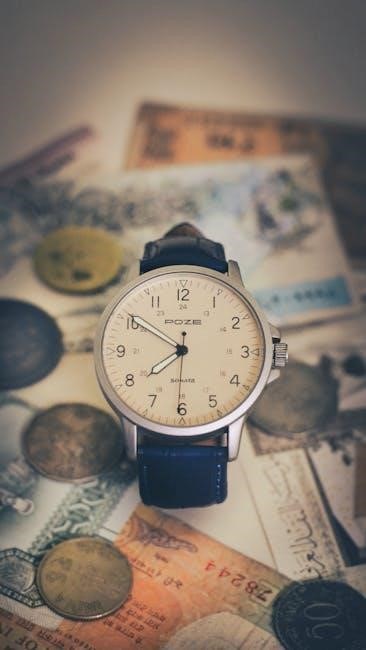
Factors Influencing Coin Values
Rarity‚ condition‚ and historical significance are key factors influencing coin values. Metal composition‚ limited mintage‚ and market demand also play a crucial role in determining worth.
Rarity‚ Condition‚ and Historical Significance
Rarity‚ condition‚ and historical significance are crucial factors influencing the value of Australian coins. Rare coins like the 1930 Proof Penny command high prices due to limited supply. Pristine condition coins‚ with minimal wear‚ are highly sought after. Historical significance‚ such as coins commemorating events or featuring cultural themes‚ enhances value. Error coins‚ like the 1988 Coat of Arms Error‚ are prized for their uniqueness. Limited mintage and unique designs further boost value. These factors‚ combined with market demand‚ determine a coin’s worth‚ making them valuable for collectors and investors alike.
Metal Composition and Market Demand
Metal composition significantly impacts the value of Australian coins‚ with precious metals like gold and silver adding intrinsic worth. High-grade silver and gold coins‚ such as the Australian Kangaroo series‚ are highly sought after. Market demand drives value‚ with rare and commemorative coins experiencing increased interest. Limited mintage editions‚ such as the 2012 Red Poppy coin‚ further enhance desirability. Bullion coins‚ containing pure gold or silver‚ attract investors seeking tangible assets. The demand for these coins often rises with global precious metal prices‚ making them a stable investment option. This dual appeal to collectors and investors ensures sustained market interest and value appreciation.
Limited Mintage and Unique Designs
Limited mintage and unique designs significantly enhance the value of Australian coins. Coins with restricted production runs‚ such as the 2012 Red Poppy 20 Cent‚ become highly sought after due to their rarity. Unique designs‚ often featuring cultural or commemorative themes‚ add artistic and historical appeal. For instance‚ coins celebrating Indigenous art or national events are particularly prized. The combination of limited production and distinctive designs makes these coins stand out‚ attracting both collectors and investors. Such exclusivity not only boosts their market demand but also elevates their status as treasured numismatic pieces‚ making them a valuable addition to any collection.

Coin Grading and Certification
Coin grading and certification ensure authenticity and quality. The 1-70 scale evaluates condition‚ with higher grades indicating better preservation. Certified coins‚ like those from PCGS or NGC‚ command premium values due to verified authenticity and quality‚ enhancing trust and market value for collectors and investors.
Understanding the Grading Scale (1-70)
The grading scale from 1 to 70 evaluates a coin’s condition‚ with 70 being flawless. Circulated coins are graded as MS (Mint State)‚ while proofs are graded as PF. Higher grades indicate better preservation‚ rarity‚ and value. For example‚ an MS-70 coin is considered perfect‚ while lower grades reflect more wear. This system‚ used by third-party services like PCGS and NGC‚ ensures consistency and transparency. Grading helps collectors and investors determine a coin’s authenticity and market worth‚ making it a critical factor in numismatic investments. A well-graded coin often commands higher prices due to its verified quality and condition.
Proof Coins and Their Value
Proof coins are highly sought after for their superior quality and mirror-like finish. Produced in limited quantities‚ these coins are struck multiple times to achieve intricate details. They are graded on a 1-70 scale‚ with higher grades commanding premium prices. Australian proof coins‚ such as commemorative issues‚ often feature unique designs and themes. Their value is influenced by rarity‚ condition‚ and historical significance. Proof coins are popular among collectors and investors‚ as they serve as both artistic pieces and valuable assets. A PDF guide can help identify and evaluate these coins‚ making them a treasured addition to any collection. Their allure lies in their beauty and investment potential.
Third-Party Certification: PCGS and NGC
Third-party certification by PCGS (Professional Coin Grading Service) and NGC (Numismatic Guaranty Corporation) ensures coins are authenticated‚ graded‚ and encapsulated. These services verify a coin’s condition‚ rarity‚ and legitimacy‚ providing a trusted standard. Graded coins receive a numerical score (1-70)‚ with higher grades indicating better preservation. PCGS and NGC certifications enhance a coin’s value and market confidence. For Australian coins‚ such as rare error or proof issues‚ these certifications are crucial for verifying authenticity and quality. A PDF guide can help collectors understand the grading process and the importance of third-party certification in determining a coin’s worth. This ensures transparency and trust in transactions.
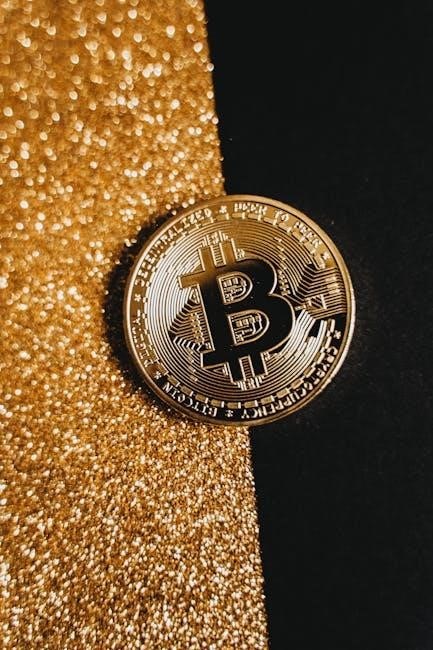
Resources for Australian Coin Collectors
Downloadable PDF guides and online databases provide detailed coin lists‚ values‚ and historical insights. Platforms like CoinID and CoinCatalog.NET offer comprehensive resources for identifying and valuing Australian coins.
Free PDF Guides for Coin Collectors
Free PDF guides provide comprehensive lists and detailed information on Australian coins‚ including values‚ mintage details‚ and historical insights. These downloadable resources are perfect for organizing and managing collections. They often feature high-quality images‚ filtering options‚ and cultural context‚ making them invaluable for both beginners and advanced collectors. Guides like the Australian Coins List and Value PDF offer insights into rare and error coins‚ helping enthusiasts identify and evaluate their finds. Accessible and informative‚ these free resources enhance the collecting experience‚ ensuring collectors stay updated on market trends and numismatic heritage.
Online Databases and Catalogs
Online databases like CoinCatalog.NET and the Royal Australian Mint offer extensive catalogs of Australian coins‚ providing detailed information on mintage numbers‚ market trends‚ and historical context. These platforms allow users to filter by year‚ denomination‚ and metal type‚ making it easy to identify rare and valuable coins; High-quality images and accurate valuations assist collectors in verifying the authenticity and condition of their coins. Regular updates ensure that collectors stay informed about new releases and shifts in market demand‚ making these databases essential tools for building and maintaining a comprehensive collection.
Reliable Platforms for Coin Valuation
Reliable platforms such as CoinCatalog.NET and the Royal Australian Mint provide accurate coin valuations‚ offering detailed information on mintage numbers‚ market trends‚ and historical data. These platforms enable users to filter coins by year‚ denomination‚ and metal type‚ ensuring precise valuations. High-quality images and pricing guides help collectors assess coin condition and rarity. Auction records and market trends are also accessible‚ aiding in informed decision-making. These tools are indispensable for determining the value of both circulating and collectible coins‚ ensuring collectors and investors make well-informed choices when buying or selling Australian coins.
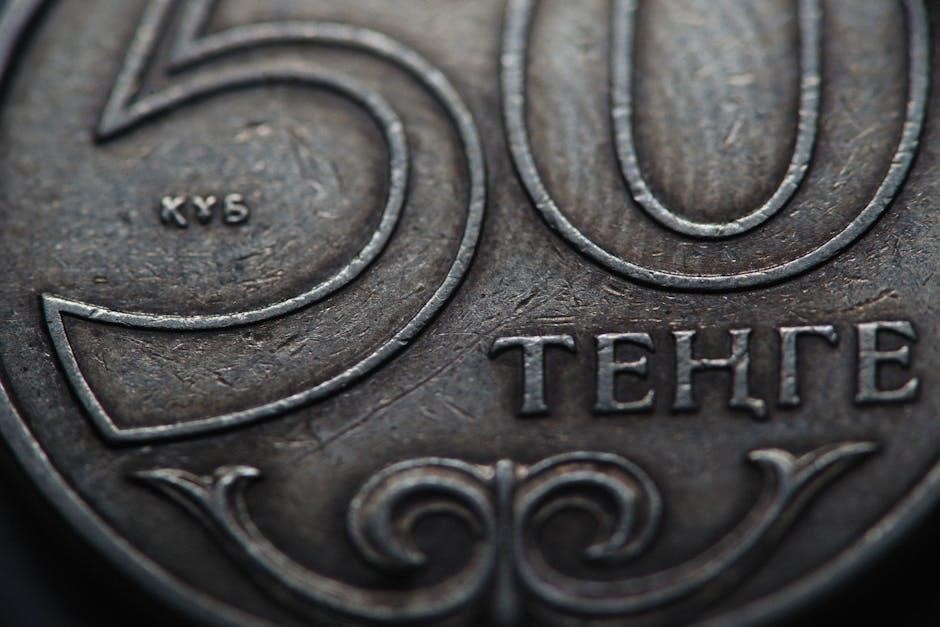
Cultural and Historical Significance
Australian coins reflect the nation’s rich history and cultural identity‚ featuring iconic symbols and commemorative themes that highlight its heritage and unique storytelling through numismatic designs.
Australian Coins as Reflections of National Identity
Australian coins are more than currency; they are canvases of national identity‚ showcasing iconic symbols like kangaroos‚ koalas‚ and cultural motifs. These designs highlight Australia’s unique heritage‚ celebrating its wildlife‚ landscapes‚ and Indigenous art. Commemorative coins often honor significant events‚ such as historical anniversaries or cultural celebrations‚ embedding the nation’s story into each piece. By featuring Aboriginal designs and themes‚ Australian coins bridge the past and present‚ fostering pride and connection to the land. This numismatic storytelling makes each coin a tangible representation of Australia’s diverse and vibrant identity‚ cherished by collectors and citizens alike.
Indigenous Art and Cultural Themes on Coins
Australian coins often feature Indigenous art and cultural themes‚ celebrating the nation’s rich Aboriginal heritage. Designs inspired by traditional motifs‚ such as Dreamtime stories and native wildlife‚ are prominently displayed. These coins serve as a bridge between modern Australia and its ancient roots‚ fostering cultural understanding and appreciation. The inclusion of Indigenous art highlights the significance of First Nations peoples in shaping the country’s identity. Collectors and enthusiasts alike value these coins for their unique designs and historical relevance‚ making them a meaningful addition to any collection while preserving Indigenous culture for future generations.
Commemorative Themes and Events
Australian coins frequently honor significant events and cultural milestones‚ such as the Centenary of Canberra or the Year of the Dragon. These commemorative coins feature unique designs that reflect the nation’s heritage and celebrations. Events like ANZAC Day and iconic Australian wildlife are also celebrated through special coin releases. Limited-edition coins marking these occasions are highly sought after by collectors for their historical and cultural significance. They serve as tangible reminders of Australia’s diverse history‚ blending numismatic appeal with storytelling. These coins not only preserve memories but also offer a visual narrative of the country’s evolving identity and values over time.
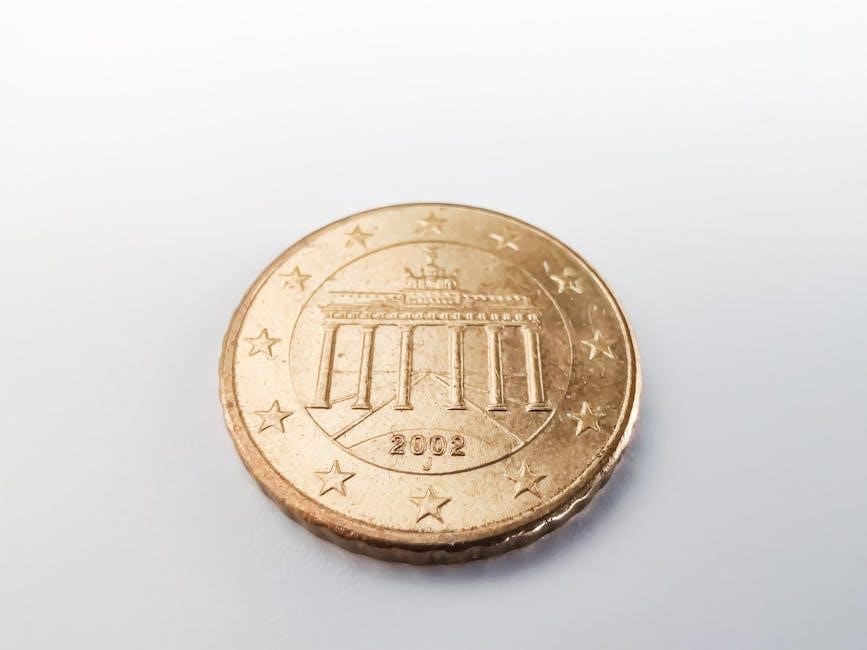
Investment Potential of Australian Coins
Australian coins offer a stable investment avenue due to their historical and cultural significance. Rare and error coins‚ like the 1930 Proof Penny‚ can significantly appreciate in value‚ making them a valuable addition to any investment portfolio.
Rare and Error Coins as Investment Assets
Rare and error coins‚ such as the 1930 Proof Penny and the 1988 Coat of Arms error‚ offer significant investment potential. These coins often appreciate in value due to their historical significance and limited availability. Error coins‚ like the 2012 Red Poppy 20 Cent‚ are highly sought after for their uniqueness‚ with values far exceeding their face value. Investors gravitate toward these assets for their cultural and monetary worth. The condition‚ rarity‚ and authenticity of these coins play a crucial role in determining their value. Professional grading and certification further enhance their appeal‚ making them a wise choice for diversifying investment portfolios while preserving history and culture.
Gold and Silver Bullion Coins
Australian gold and silver bullion coins‚ such as the iconic Kangaroo series‚ are highly prized for their purity and design. These coins are minted with high-quality precious metals‚ making them a stable investment choice. The Kangaroo and Koala series‚ produced by the Perth Mint‚ feature intricate designs that celebrate Australian wildlife. Bullion coins are sought after for their intrinsic metal value and potential appreciation. Collectors and investors alike value these coins for their beauty‚ durability‚ and as a hedge against inflation. A PDF guide helps identify and evaluate these coins‚ ensuring informed decisions for both collection and investment purposes‚ while highlighting their cultural significance.
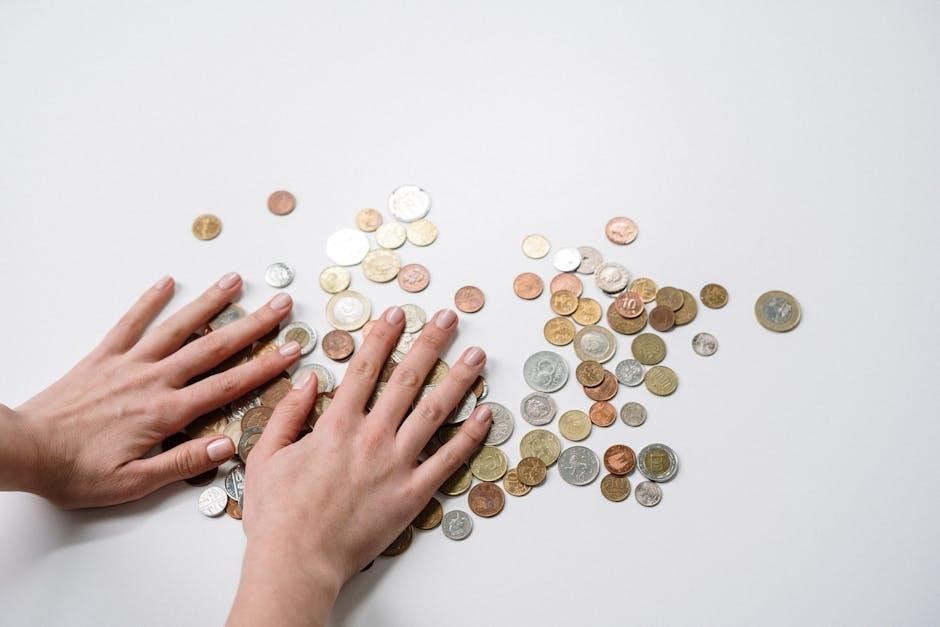
Stability and Growth in Numismatic Investments
Australian coins offer stability and growth in numismatic investments due to their historical and cultural significance. Rare and error coins‚ such as the 1930 Proof Penny‚ appreciate over time‚ making them valuable assets. Gold and silver bullion coins‚ like the Kangaroo series‚ combine intrinsic metal value with potential price growth. Limited mintage and high-grade conditions further enhance their appeal. Investors benefit from the tangible nature of coins‚ which often perform well during economic uncertainty. A PDF guide provides insights into market trends and valuation‚ helping collectors and investors make informed decisions to diversify their portfolios and achieve long-term growth.
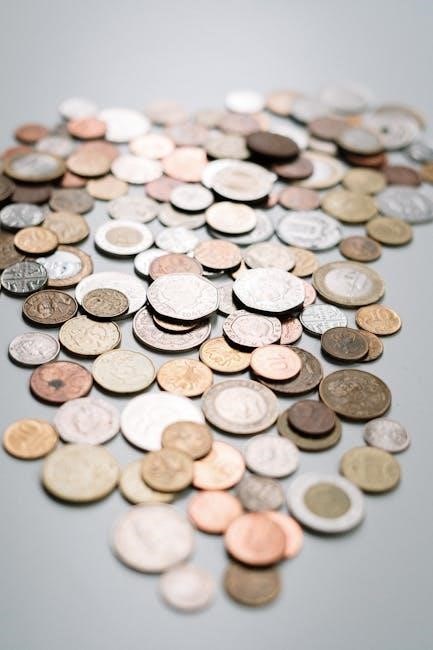
Practical Tips for Collectors
Start with common coins and use a PDF list to identify rare issues. Prioritize condition and rarity for maximum value. Stay informed about market trends to make informed decisions.
Starting a Collection: Beginners Guide
Starting an Australian coin collection is an exciting journey! Begin by understanding the hobby and gathering essential resources‚ such as a PDF list of Australian coins. This guide helps identify rare and valuable coins‚ ensuring you make informed decisions. Begin with common circulation coins and gradually seek rare issues like the 2012 Red Poppy. Use online databases and free downloadable PDF guides to track your collection and stay updated on values. Prioritize coin condition‚ rarity‚ and historical significance for maximum value. Join collector communities for tips and support‚ and consider professional grading for rare finds to enhance your collection’s authenticity and worth.
Building and Maintaining a Collection
Building and maintaining an Australian coin collection requires careful organization and research. Use a PDF list to track your coins and identify gaps. Regularly update your collection with new releases and rare finds. Store coins in protective albums or folders to preserve condition. Consider professional grading for rare or valuable coins to enhance authenticity. Stay informed about market trends and coin values through reliable resources. Periodically review your collection to ensure accuracy and completeness. A well-maintained collection not only retains value but also serves as a cherished legacy. Utilize online guides and catalogs to stay updated and make informed decisions.
Engaging with the Coin Collecting Community
Engaging with the coin collecting community enriches your hobby and expands knowledge. Join online forums‚ clubs‚ and social media groups dedicated to Australian numismatics. Attend coin shows and auctions to network with fellow enthusiasts and gain insights. Participate in discussions about rare coins‚ error pieces‚ and market trends. Share your collection highlights and learn from others’ experiences. Many communities provide access to PDF guides and resources‚ helping you identify and evaluate coins. Collaborative learning fosters camaraderie and enhances your collecting journey. Active involvement in the community can lead to new discoveries and opportunities to acquire rare or unique coins for your collection.
Australian coin collection is a rewarding journey‚ blending history‚ culture‚ and personal passion. A PDF list is an invaluable tool for organizing and managing your collection effectively‚ ensuring a seamless and enjoyable experience for enthusiasts of all levels.
Final Thoughts on Australian Coin Collecting
Australian coin collecting is a captivating hobby that combines history‚ culture‚ and personal passion. The availability of a PDF list simplifies organizing and managing collections‚ offering detailed insights into rare and valuable coins. This resource is invaluable for both beginners and seasoned collectors‚ providing a comprehensive guide to navigate the world of Australian numismatics. By leveraging such tools‚ enthusiasts can deepen their understanding‚ make informed decisions‚ and appreciate the unique stories behind each coin. Whether for enjoyment or investment‚ Australian coin collecting remains a rewarding journey‚ enriched by its cultural and historical significance.
The Future of Australian Numismatics
The future of Australian numismatics looks promising‚ with evolving technologies and innovative coin designs attracting new enthusiasts. The use of PDF lists and digital tools will continue to simplify collection management‚ making it accessible to a broader audience. As collectors embrace these resources‚ the hobby is expected to grow‚ fostering a community that values both tradition and modern advancements. With a focus on rare and error coins‚ the market is likely to see increased interest‚ driven by their historical significance and collectible appeal. This blend of heritage and innovation ensures Australian numismatics remains vibrant and dynamic for years to come.
Related posts:
Archives
Calendar
| M | T | W | T | F | S | S |
|---|---|---|---|---|---|---|
| 1 | 2 | 3 | 4 | 5 | 6 | 7 |
| 8 | 9 | 10 | 11 | 12 | 13 | 14 |
| 15 | 16 | 17 | 18 | 19 | 20 | 21 |
| 22 | 23 | 24 | 25 | 26 | 27 | 28 |
| 29 | 30 | 31 | ||||
Leave a Reply
You must be logged in to post a comment.